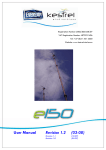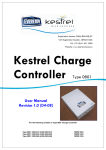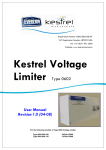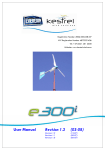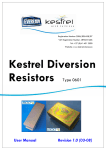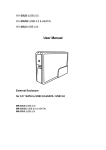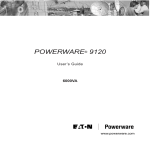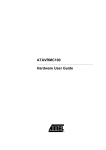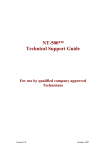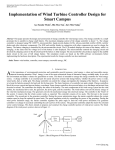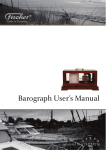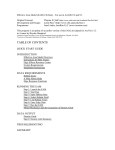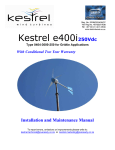Download DUMP REGULATOR e0401 REV 1.1 - Kestrel Wind Turbines-Home
Transcript
Charge Controller Manual Approval: Document #: 0102M01 Date: June ’07 REV : 1.2 Page 1 of 17 Registration Number 2006/005438/07 VAT Registration Number 4870231406 Tel: +27 (0)41 401 2500 Website: www.kestrelwind.co.za Kestrel Dump Regulator Type 0401 Users Manual Revision 1.0 (October 07) For the following models of type 0401 charge regulator Type 0401–0600-012 (e150-001-012) Type 0401-0600-024 (e150-001-024) Type 0401-0600-048 (e150-002-048) 600W 600W 600W 50A 35A 20A Type 0401-0800-012 (e220-001-012) Type 0401-0800-024 (e220-001-024) Type 0401-0800-048 (e220-001-048) 800W 800W 800W 50A 35A 20A Type 0401-1000-012 (e300i-001-012) Type 0401-1000-024 (e300i-001-024) Type 0401-1000-048 (e300i-001-048) 1000W 60A 1000W 40A 1000W 25A Charge Regulator Manual Approval: Document #: 0401M01 Date: October ’07 REV : 1.1 Page 2 of 17 CONTENTS PAGE 1 Safety Considerations 1.1 1.2 1.3 1.4 2 Components Components Supplied Components not Supplied Tools Required Unpacking 5 5 5 5 Typical Installation Example Mounting the Dump Regulator Electrical Wiring Adjusting the Charging Voltage Adjusting the Switching Delay 6 7 8 9 9 Wiring and Cable Sizing 5.1 5.2 5.3 5.4 6 4 4 4 Installation Instructions 4.1 4.2 4.3 4.4 4.5 5 Dump Regulator Description Identification and Markings Applications and uses Dump Regulator Assembly 3.1 3.2 3.3 3.4 4 3 3 3 3 Dump Regulator Overview 2.1 2.2 2.3 3 Mechanical Safety Electrical ical Safety Electr Installation Hazards Operational Safety Wind Turbine Wiring Battery Wiring Lightning Protection Wire Tables 10 10 10 10 10 11 11 Battery Considerations 6.1 6.2 6.3 6.4 Lead Acid Batteries Sealed Gel Batteries NiNi-Cad Batteries Batteries Temperature Compensation 12 12 12 2 1 12 12 12 12 7 Technical Specifications 13 13 8 Trouble shooting 14 14 9 Maintenance 15 15 10 Warranty Conditions 15 15 11 Customer Feedback 17 17 Charge Regulator Manual Approval: Document #: 0401M01 Date: October ’07 REV : 1.1 Page 3 of 17 Note: The dump regulator Type 0102 must be installed with a separate divert resistor. Disclaimer Kestrel Wind Turbines makes every effort to give accurate information in this manual and is in no way liable for any error or omission. The user of this manual assumes full responsibility and risk. We appeal to your common sense to read and apply the safety notes. Consult professional engineers and take advice if you are unsure. 1 Safety Considerations 1 SAFETY FIRST 1.1 1.2 1.3 1.4 Mechanical Safety Electrical Safety Installation Hazards Operational Safety Although Kestrel’s dump regulators are designed with your safety in mind, accidents can easily occur and there are always inherent dangers associated with any type of machine. Consult installation professionals if you lack experience or confidence. 1.1 Mechanical Safety Use good handling methods and take precautions to avoid physical injury during installation and maintenance/repair procedures. Be responsible when using all tools whether manual or powered. 1.2 Electrical Safety Read and adhere to the installation instructions for this product. Do not work on the system when the wind turbine is running or when lightning is possible. Disconnecting and re-connecting wires may cause a spark and the presence of explosive hydrogen from battery charging is always a possibility. Adequate ventilation must be provided for battery installations. The wire size used for connections must be correct for the powers supplied. The smaller the wire diameter, the higher the wire losses and therefore the heat generated in the wire. Use correct wire sizes throughout the installation. The amount of energy stored in a battery is considerable and fire can result from shorts. Fit a suitable fuse or circuit breaker in the battery cable. In general, respect the system and use common sense. Consult a qualified electrician if you are unsure. 1.3 Installation Hazards Be sure to read and adhere to the installation instructions for this product. Always work carefully and have an assistant wherever possible. Always re-check the work as you progress. Slack bolts, poor workmanship and loose electrical connections must be avoided. Operational 1.4 Op erational Safety Be aware that the dump regulator will become hot during certain operation modes. This is quite normal but be aware of high temperatures within the case. System checks are best carried out in calm weather conditions. Avoid any maintenance or inspection during windy weather. 3 Charge Regulator Manual Approval: Document #: 0401M01 Date: October ’07 2 DUMP REGULATOR OVERVIEW 2.1 Dump Regulator Description REV : 1.1 Page 4 of 17 2 Dump Regulator Overview 2.1 Dump Regulator Description 2.2 Identification and Markings 2.3 Application and Uses IMPORTANT: A suitable divert power resistor must be installed with this product Sustainable/renewable energy sources such as wind turbines and solar panels generate uncontrolled power that must be regulated to facilitate the correct and safe charging of storage batteries. The Kestrel Type 0401 dump regulator uses electronic means to regulate the incoming power to the installed battery. The product uses simple technology causing no electrical disturbance during operation. Power from the wind turbine is delivered through the product to the battery system. The regulator monitors the battery/system voltage and supplies power for load consumption and battery charging. The wind turbine continually supplies the load and battery until the battery voltage reaches the float level. The regulator then transfers the wind turbine from the battery to a diversion resistor. As the battery voltage reduces, the regulator re-transfers the wind turbine from the diversion resistor back on to the battery. The cycle then repeats. Any excess energy is converted to heat in the diversion resistor. The regulator also maintains an optimum load on the turbine at all times to prevent the turbine speed becoming excessive. The unit is highly efficient and allows the wind turbine to bulk charge very low or flat batteries. Since the controller is external to the generator, it can be sited close to the batteries. This gives accurate battery voltage measurement and tight regulation. 2.2 Identification and Markings On the cover of the charge controller is a product rating plate and serial number, if the charge controller does not carry this stamp it does not carry a Kestrel warranty and may not be authentic. 2.3 Applications Applications and Uses The Kestrel Charge Controller Type 0102 is primarily intended for use with Kestrel wind turbines that are installed for battery charging. Each application may require specific additional electrical equipment. Consult the manuals supplied with this equipment. 4 Charge Regulator Manual Approval: Document #: 0401M01 Date: October ’07 REV : 1.1 Page 5 of 17 3 Dump Regulator Assembly 3 DUMP REGULATOR ASSEMBLY 3.1 3.2 3.3 3.4 Components Supplied Components Not Supplied Tools Required Unpacking 3.1 Components Supplied The following components are supplied: Dump Regulator assembly User Manual 3.2 Components Not Supplied The following components are necessary to complete an installation: Electrical crimp terminals Wall fixing screws 20mm cable glands Suitable fixing screws or bolts 3.3 3.3 Tools Required The following hand tools are required for the charge controller installation: Small size electrical screwdriver Medium size electrical screwdriver Wire strippers for electrical connections Electrical crimping pliers Tape measure for positioning 3.4 3.4 Unpacking Open the packaging container and check for any transit damage. The parts contained are listed in section 3.1 and on the included packing slip. Lay out and identify the parts. 5 Charge Regulator Manual Approval: Document #: 0401M01 Date: October ’07 REV : 1.1 Page 6 of 17 4 Installation Instructions 4 INSTALLATION INSTRUCTIONS 4.1 Typical Installation Example 4.1 4.2 4.3 4.4 Typical Installation Example Mounting the Regulator Electrical Wiring Adjusting the Charging Voltage A typical battery charging installation is shown below. The system comprises a Kestrel wind turbine, dump regulator or charge controller, diversion resistor, battery and an inverter. The inverter is additional and converts the battery dc power into standard ac power such that common mains powered appliances can be supplied. NOTE: The load circuit breaker and inverter are additional equipment and not supplied with the dump regulator. The diversion resistor is supplied as a separate item. The Type 0401 dump controller must have a diversion resistor fitted. 6 Charge Regulator Manual Approval: Document #: 0401M01 Date: October ’07 REV : 1.1 Page 7 of 17 4.2 Mounting the Regulator The Kestrel dump regulator Type 0401 is only suitable for indoor installation. The unit must be vertically mounted using the four external fixing holes provided. Use secure fastening with suitable wall plugs or bolts. Allow a minimum of 100mm (4”) space all around the unit for cooling. It is normal for the regulator to become quite hot at times as it dissipates unwanted energy. Do not place any objects on the top of the enclosure. The unit relies on the free passage of air through the heat sink for cooling. 7 Charge Regulator Manual Approval: Document #: 0401M01 Date: October ’07 REV : 1.1 Page 8 of 17 4.3 4.3 Electrical Wiring Observe the Polarity at all times. Only connect +VE RED cables to +VE RED terminals and -VE BLACK cables to -VE BLACK terminals. Otherwise, equipment damage may result and any warranty will be invalidated. PLEASE FOLLOW THE INSTRUCTIONS BELOW ! CONSULT SECTION 5 FOR WIRE SIZE RECOMMENDATIONS The dump regulator is provided with two pairs of +VE and -VE clearly marked terminals for "TURBINE" and "BATTERY" and one pair of DIVERT RESISTOR terminals clearly marked R1A and R1B at the bottom of the regulator. The TURBINE BRAKE switch is designated “S1” and the BATTERY CIRCUIT BREAKER is designated “Q1”. If these items are not fitted within the controller, they should be installed externally to suit local electrical requirements. The turbine brake switch stops the turbine by creating an electrical short on the turbine input. When operated, this prevents high turbine open circuit voltages being developed. The wind turbine should not be rotating during this installation. If turbine access is not possible, short the two turbine power wires together. Observe the Polarity at all times. Only connect +VE RED cables to +VE RED terminals and -VE BLACK cables to -VE BLACK terminals. a) Arrange the wires from the turbine and the battery ready for connection. b) Check that the turbine wires are shorted. Check that the battery wires are disconnected from the battery or that any additional battery fuse or circuit breaker is disabled. c) Check that the regulator BATTERY CIRCUIT BREAKER (Q1) is switched OFF and that the TURBINE BRAKE SWITCH (S1) is switched ON. d) Connect the wiring between the regulator terminals R1A and R1B to the divert resistor enclosure terminals R1A and R1B respectively. e) Connect the battery wires to the regulator battery terminals +VE and –VE observing polarity. f) Connect an electrical earth wire to the marked earth screw terminal provided. g) Separate the turbine wires and connect the turbine negative wire to the controller turbine negative terminal. You may have to improvise by maintaining a short on the turbine wires as this connection is made. h) Finally connect the turbine positive wire to the regulator turbine positive terminal. i) Switch the battery circuit breaker ON. (There is no reaction) j) Switch the turbine switch OFF. (If enough wind is present, the green LED on the control board will illuminate showing the turbine to be active) The instructions are reversed for de-commissioning. First disconnect or switch the battery off. Then remove the turbine wires and then the battery connections. A disconnected turbine should always be shorted. 8 Charge Regulator Manual Approval: Document #: 0401M01 Date: October ’07 REV : 1.1 Page 9 of 17 4.4 4.4 Adjusting the Charging Voltage Always switch the turbine brake on (S S1 ON) and the battery circuit breaker off (Q Q1 OF F ) before adjusting the charging voltage jumper The Kestrel dump regulator Type 0401 is suitable for all lead acid batteries whether vented, semi-sealed or sealed and the charging voltage may be adjusted. When the cover is removed, the jumper is visible in the middle of the control board. The charging voltage may be adjusted to the following table. There are five positions for the jumper. The value is the charging cell voltage. The derived battery charging voltages are given in the tables below. Consult your battery supplier for the correct charging voltage. Charging voltages for 12V system - - 2,366 2,350 2,333 2,315 2,300 14,2V 14,1V 14,0V 13,9V 13,8V Charging voltages for 24V system - - 2,366 2,350 2,333 2,315 2,300 28,4V 28,2V 28,0V 27,8V 27,6V Charging voltages for 48V system - - 2,366 2,350 2,333 2,315 2,300 56,8V 56,4V 56,0V 55,6V 55,2V 4.5 4.5 Adjusting the Switching Delay The regulator diverts all the turbine power when the battery is charged; it is possible for the battery voltage to drop quite quickly under certain load conditions. This can cause the regulator to cycle on and off. This behaviour is prevented by a digital timer. Select the minimum time to end a power diversion by re-positioning the timer jumper on the top of the PCB board. Three times are available, 30s, 30m and 1hr. 9 Charge Regulator Manual Approval: Document #: 0401M01 Date: October ’07 5 WIRING WIRING AND CABLE SIZING SIZING REV : 1.1 Page 10 of 17 5 Wiring and Cable Sizing 5.1 Wind Turbine Wiring 5.1 5.2 5.3 5.3 Wind Turbine Wiring Battery Wiring Lightning Protection Wire Tables Kestrel wind turbines produce dc power and output on two double insulated output wires (tails). The RED wire is POSITIVE and the BLACK wire is NEGATIVE Observe the Polarity at all times. Only connect +VE RED cables to +VE RED terminals and -VE BLACK cables to -VE BLACK terminals. Otherwise, equipment damage may result and any warranty will be invalidated. The following suggestions are made as a guideline. If you are in doubt, consult an electrician. The output wires must be extended as required for the installation. Choose the wire size that is suggested for the size of turbine, electrical current and the distance from the turbine to the charge controller. Good wire connections are absolutely essential to avoid poor power delivery and high temperatures at the connection. All electrical systems lose energy because cables have a resistance. The mounting structure must be directly earthed for lightning. The power cable is usually brought down the inside of the mounting structure to give some protection. Supply cables should never be spanned or suspended from the turbine structure and should be buried at least one half metre deep in a suitable plastic or steel conduit. 5.2 Battery Wiring The battery wiring is usually chosen to be the same size as the turbine power wiring but a smaller wire diameter can be used because the distance is usually much shorter between the charge controller and the battery. 5.3 Lightning protection Proper grounding is essential to protect the system from induced voltages and static. The installation must comply with local requirements for electrical installations. Ensure that the generator is electrically connected to the mounting structure and that the structure is earthed. This is usually done by burying a 2 to 3m (6’ – 10’) length of water pipe (steel or copper) horizontally, 800mm (2,5’) below the ground surface. A good connection is made between the middle of the pipe and the structure. An improved method is to bury a cross of pipe, which requires an "X" shape to be excavated. The connection is made in the centre of the cross. The negative battery connection should also be grounded using a ground point close to the battery. The wire size for grounding should be the same size as the power cables. Commercial lightning arrestors are available at electrical stores and can be fitted at the bottom of the structure or pole or at the regulator input. 10 Charge Regulator Manual Approval: Document #: 0401M01 Date: October ’07 REV : 1.1 Page 11 of 17 5.4 Wire Tables The copper wire sizes given in the tables are calculated for 3% power loss in wire resistance. This is usually acceptable in low voltage installations. A larger wire size will increase the delivered power but usually a compromise is reached as larger cables cost more. It is recommended that the wire sizes given be taken as a minimum value. Measure the distance from the top of your structure (i.e. the e150) to the regulator. Select the wire size for that distance from the table. The double run of +ve and -ve is already accounted for. The power cable should be run down the inside of the pole or structure and then buried in a suitable underground conduit at least 500mm below the ground surface. Wire lengths account for a double cable run (both +ve and –ve together) being given in metric metres (m) and imperial feet (‘). Wire cross sectional area is given in metric square millimetres (sq mm) and American Wire Gauge AWG. Wire Size for 12V (60A maximum current) 10m (33’) 35sq mm (2) 20m (66’) 45sq mm (1) 30m (96’) 85sq mm (000) Wire Size for 24V (32A maximum current) 10m (33’) 16sq mm (5) 20m (66’) 35sq mm (2) 30m (96’) 50sq mm (0) 40m (130’) 70 sq mm (00) 50m (165’) 95 sq mm(0000) 40m (130’) 50m (165’) Wire Size for 48V (19A maximum current) 10m (33’) 20m (66’) 30m (96’) 10sq mm (7) 20sq mm (4) 35sq mm (2) 35sq mm (1) 50sq mm (0) 80m(260’) 70sq mm (00) 100m (330’) 100sqmm(0000) 11 Charge Regulator Manual Approval: Document #: 0401M01 Date: October ’07 REV : 1.1 Page 12 of 17 6 Battery Considerations 6 BATTERY CONSIDERATIONS CONSIDERATIONS 6.1 6.2 6.3 6.4 Lead Acid Batteries Sealed Gel Batteries Ni-Cad Batteries Temperature Compensation Batteries are available in many shapes, sizes and chemistry. Battery dealers will be pleased to assist. The most common ones are reviewed below. In general, only "Deep cycle" batteries and cells should be used and automotive or vehicle batteries will have a short life as they are not designed for cyclic charging and discharging. A cell is a single unit of 2V and a battery consists of a number of cells joined in series. The usual installation consists of 12V batteries arranged in series or parallel, or both. Batteries should not be exposed to temperature extremes and good ventilation is required as batteries can emit hydrogen while being charged. The stored energy in a battery is given in Ampere Hours (Ah) or Watt hours (Wh). The capacity is often based on a 10 hour discharge rate. A 100Ah battery will therefore supply a current of 5A for 20hrs or 10A for 10hrs or 20A of current for 5hrs. It will not however supply 100A of current for 1hr. There is much literature available on this subject. The installed battery capacity in Ah is calculated from the autonomy in the system. The autonomy is the time that the battery must supply power to the load with no wind energy being input. The question to be answered is therefore, “How long must the battery run the load when there is no wind?”. Other considerations relate to the charging current available from the wind turbine and the time allowed for the batteries to recover to a state of full charge. Consult your dealer or battery supplier. 6.1 Lead Acid Batter Batteries. ies. These are the most popular choice of battery type and can be vented/flooded (water may be added), or semi-sealed or low maintenance (water cannot be added). Charging voltage is typically 13.8-14.0 / 27.6-28.0Vdc for these batteries. 6.2 Sealed Gel B Batteries atteries Sealed gel batteries are more expensive but offer clean and safer operation as no acid can be spilled. Since they are sealed, they must never be boosted and the charging voltage is important. Charging voltage is typically 14.0 / 28.0Vdc. Consult your battery supplier. 6.3 Ni Ni--Cad Batteries This type of battery is traditionally used where large currents must be delivered and where deep cycling is required. They are however relatively expensive. Consult your battery supplier for details. 6.4 Tempera Temperature ture Compensation Much has been documented on this subject and there are certain merits. Generally, lower and higher ambient temperatures allow higher and lower charging voltages respectively. K600 regulators do not have this facility. Batteries should be sited in a cool area and temperature compensation is only useful in extreme temperature variations. 12 Charge Regulator Manual Approval: Document #: 0401M01 Date: October ’07 REV : 1.1 Page 13 of 17 7 TECHNICAL SPECIFICATIONS General: Switch diversion dump regulator to telecommunication specification with 600, 800 and 1000W capability for the charging of storage batteries. Supplied to order for system voltages of 12, 24, 48Vdc. Controller Model Rated Power Maximum Current Type 0401–0600-012 (e150-002-012) Type 0401-0600-024 (e150-002-024) Type 0401-0600-048 (e150-002-048) 600W 600W 600W 50A 25A 15A Type 0401-0800-012 (e220-002-012) Type 0401-0800-024 (e220-002-024) Type 0401-0800-048 (e220-002-048) 800W 800W 800W 60A 30A 20A Type 0401-1000-012 (e300i-002-012) Type 0401-1000-024 (e300i-002-024) Type 0401-1000-048 (e300i-002-048) 1000W 1000W 1000W 60A 40A 25A Input voltage and variation 12Vdc (0-40V), 24Vdc (0 – 60V) 48Vdc (0 – 100V) Efficiency 12V - 97%, 24V and 48V– 99% at full load Input frequency N/A dc input Input Protection Polarity reversal Input power factor Output Voltage N/A dc input Adjustable for 2,30V, 2,316V, 2,333V, 2,35V, 2,366V VPC Output voltage ripple Output voltage regulation User control User controls external LED Indication Cooling <1%rms <1% PCB Jumper for output voltage setting None Internal running LED (Green) Natural Convection Maximum Ambient 40deg C IP Rating IP35 Cabinet Dimensions (wall mounting) Certification 230Wx230Hx130D Complies with EMC requirements CIS22 Class B 13 Charge Regulator Manual Approval: Document #: 0401M01 Date: October ’07 REV : 1.1 Page 14 of 17 8 TROUBLE SHOOTING THE KESTREL TYPE 0401 DUMP REGULATOR MAY BE SERIOUSLY DAMAGED FROM POLARITY REVERSAL. (wrong connection of +ve and –ve wiring). THE CONTROLLER MUST BE WIRED IN CONJUNCTION WITH A SUITABLE DIVERSION POWER RESISTOR. CONTROLLER FAILURE AND/OR OVERCHARGING OF THE BATTERY CAN OCCUR WITH THE WRONG VALUE OF DIVERSION RESISTOR. IF FOR ANY REASON THE WIND TURBINE IS DISCONNECTED, SHORT THE GENERATOR OUTPUT WIRES. THIS WILL LOAD THE GENERATOR AND MINIMISE ROTATION. WHEN THE CONTROLLER IS CONNECTED TO A SOLAR PANEL SYSTEM, THE OUTPUT VOLTAGE JUMPER MAY HAVE TO BE ADJUSTED TO BALANCE THE CHARGING FROM THE TURBINE WITH THE SOLAR PANELS. Q There is wind but the internal green LED does not come on. A The turbine stop switch is ON. The turbine has not reached the cut in voltage, a higher wind is required. There is an electrical short elsewhere in the system. Q The Battery circuit breaker trips. A Battery cables are reversed. Controller diodes are faulty. Q The regulator is always working at a high temperature. A The unit is diverting energy. Fit additional batteries and increase the load. Q Will I damage the regulator if I disconnect the battery. A No, the controller will continue to control with no battery connected. It will however become quite hot as it has to divert all the energy from the wind turbine. It is best to operate the turbine stop switch rather than have the controller working so hard for no reason. 14 Charge Regulator Manual Approval: Document #: 0401M01 Date: October ’07 REV : 1.1 Page 15 of 17 9 MAINTENANCE The Kestrel Type 0401 dump regulator is designed for continuous operation on 100% duty cycle and requires no regular part replacement. Keep the unit clean and ensure that no foreign objects reduce the airflow through the rear aluminium heat sink. Clean the case only with a soft damp cloth. Do not use any form of solvent. 10 WARRANTY CONDITIONS Kestrel’s wind turbines and dump regulators are manufactured to the highest standards, in accordance with Kestrel Wind Turbines’ standard and quality specifications, and warrants that the dump regulator is in good working order upon delivery and for a period of 24 months. Warranty terms and conditions are outlined below. 1. Eveready warrants that Regulators will, on delivery, be free of defects in design, material and workmanship and will be fit for their intended purpose for a period of two years calculated from the date of installation, subject to proper installation, maintenance and use in accordance with the User Manual. 2. This warranty is further subject to the Customer returning the defective Regulators at its cost to the premises of Eveready within the warranty period and furnishing full details in writing of the alleged defect. 3. Eveready's obligations under this warranty shall be limited to the repair or replacement of defective Regulators at its cost or to a refund to the Customer of the original cost thereof, as Eveready may determine in its discretion. Eveready shall not be responsible for any damages suffered by the Customer pursuant to any defects covered by this warranty. 4. This warranty shall not apply to any damage to Regulators caused by winds exceeding 160 kilometres per hour or any other factors beyond the control of Eveready. 5. The Customer may purchase an extended warranty from Eveready in respect of Regulators, subject to Eveready's standard conditions. 15 Charge Regulator Manual Approval: Document #: 0401M01 Date: October ’07 REV : 1.1 Page 16 of 17 CONTACT KESTREL WIND TURBINES Kestrel Wind Turbines P.O. Box 3191 Eveready Diversified Products (Pty) Ltd North End Eveready Road Port Elizabeth Struandale 6056 North End Eastern Cape Port Elizabeth Republic of South Africa South Africa Tel: +27 (0)41 401 2500 Email: [email protected] Registration Number 2006/005438/07 VAT Registration Number 4870231406 Web: www.kestrelwind.co.za 16 Charge Regulator Manual Approval: Document #: 0401M01 Date: October ’07 REV : 1.1 Page 17 of 17 10 CUSTOMER FEEDBACK Customer enquiry and feedback sheet Customer Information Information Customer Name: Postal Address: Serial Number: Phone Number: E-Mail Address: Fax Number: Enquiry Details Complete the form and submit to Kestrel Wind Turbines. Your feedback and queries are valuable to us. Indicate your enquiry or feedback in the space provided below For OFFICIAL Use Only Date Replied: Signature: Comments: 17

















